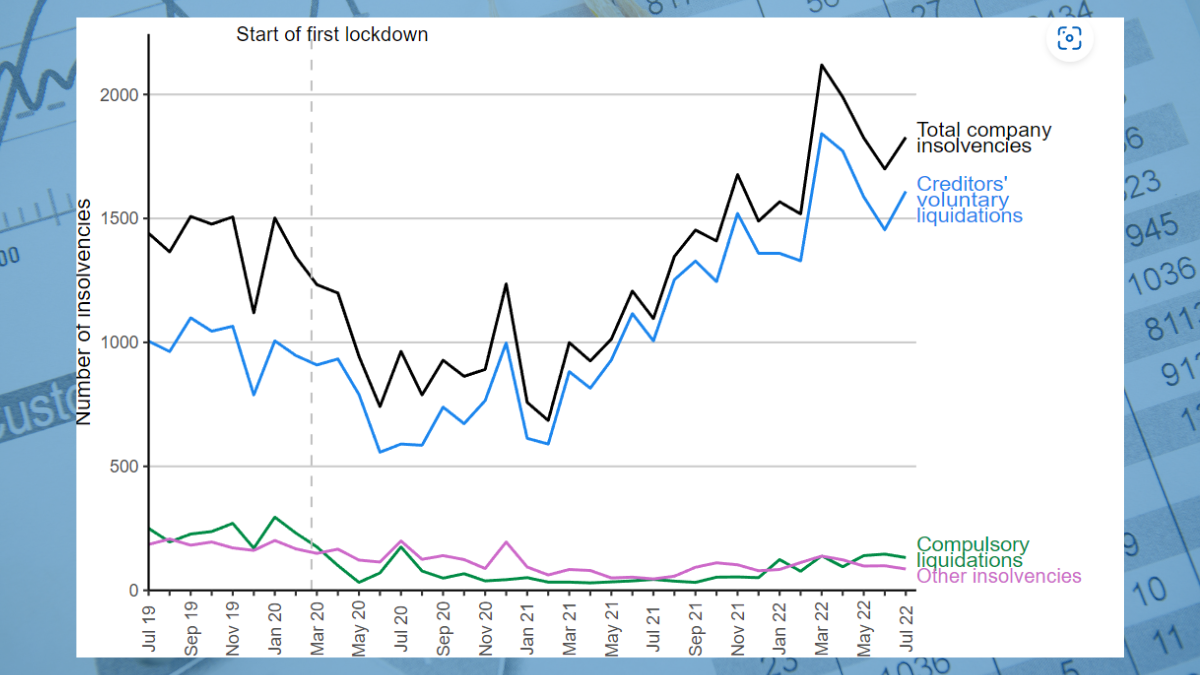Insolvency statistics released for July 2022

High insolvency rates are driven by the increasing number of CVLs
The number of registered company insolvencies in July 2022 was 1,827:
- 67% higher than in the same month in the previous year (1,096 in July 2021), and
- 27% higher than the number registered three years previously (pre-pandemic; 1,440 in July 2019).
In July 2022 there were 1,609 Creditors’ Voluntary Liquidations (CVLs), 60% higher than in July 2021 and also 60% higher than July 2019. Numbers for other types of company insolvencies, such as compulsory liquidations, remained lower than before the coronavirus (COVID-19) pandemic, although there were 3 times as many compulsory liquidations in July 2022 as in July 2021, and the number of administrations was twice as high as a year ago.
For individuals, 531 bankruptcies were registered, which was 16% lower than in July 2021 and 64% lower than July 2019.
Corporate Insolvencies
Of the 1,827 registered company insolvencies in July 2022:
- There were 1,609 CVLs, which is 60% higher than in July 2021 and 60% higher than in July 2019;
- 132 were compulsory liquidations, which is 200% (3 times) higher than July 2021, but 47% lower (half the number) than July 2019;
- Five were CVAs, which is 17% lower than July 2021 and 87% lower than July 2019;
- There were 81 administrations, which is 103% (2 times) higher than July 2021 but 45% lower than July 2019; and
- There were no receivership appointments.
Between 26 June 2020 and 31 July 2022, in England & Wales, 39 moratoriums were obtained and 12 companies had a restructuring plan registered at Companies House. These two new procedures were created by the Corporate Insolvency and Governance Act 2020.
Impact of COVID-19 business support measures
Lower numbers of compulsory liquidations is likely to be partly driven by government measures put in place to support businesses and individuals during the pandemic, including:
- Temporary restrictions on the use of statutory demands and certain winding-up petitions (leading to company compulsory liquidations).
- Enhanced government financial support for companies and individuals.
As the Insolvency Service does not record whether an insolvency is directly related to the coronavirus pandemic, it is not possible to state the direct effect of the pandemic on insolvency volumes.
Debt relief orders and bankruptcies
There were 1,835 Debt Relief Orders (DROs) in July 2022, which was similar to July 2021 but 23% lower than the pre-pandemic comparison month (July 2019).
There were, on average, 7,608 IVAs registered per month in the three-month period ending July 2022, which is 11% higher than the three-month period ending July 2021, and 4% higher than the three-month period ending July 2019. IVA numbers have ranged from around 6,300 to 7,800 per month over the past year.
The bankruptcies were made up of 401 debtor applications and 70 creditor petitions. Monthly bankruptcy numbers between July 2021 and June 2022 were lower than the numbers in 2020, which were already lower than pre-pandemic levels.
Bankruptcies were 16% lower than in July 2021. Debtor applications were 14% lower and creditor petitions were 29% lower than July 2021.
Compared to July 2019, total bankruptcies were 64% lower; debtor applications were 60% lower and creditor petitions were 77% lower.
Individual voluntary arrangements
There were, on average, 7,608 IVAs registered per month in the three-month period ending July 2022, 11% higher than for the three-month period ending July 2021 and 4% higher than the three-months ending July 2019.
Breathing Space Registrations
There were 6,112 Breathing Space registrations in July 2022, which is 10% higher than the number registered in July 2021. 5,994 were Standard breathing space registrations, which is 10% higher than in July 2021, and 118 were Mental Health breathing space registrations, which is 34% higher than the number in July 2021.
We publish a summary of the reports here each month. For advice relating to support, insolvency or recovery options, please contact Isobel Brett for further information and guidance.
* This content and data was reported in full in the Insolvency Service Statistics for July 2022 published 16 August 2022 – see the full report here:
Monthly Insolvency Statistics, July 2022 – GOV.UK (www.gov.uk)https://www.gov.uk/government/statistics/monthly-insolvency-statistics-july-2022/commentary-monthly-insolvency-statistics-july-2022
Image source: The Insolvency Service Monthly insolvency statistics, July 2022